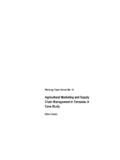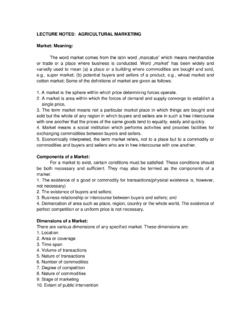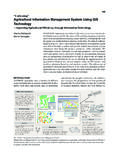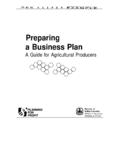Transcription of GUIDELINES FOR THE DESIGN OF AGRICULTURAL …
1 GUIDELINES FOR THE DESIGN OF AGRICULTURAL investment PROJECTS (2005 Web PDF version of 1995 revised edition) (Editor s 2005 Note: To create this web PDF it was necessary to change the layout and page numbering from the 1995 print edition. Large sections of Part II have been updated, in particular chapter 4. Use of Computers in project Analysis. A list of computer programs appearing as section 8. in the References and Bibliography in the 1995 publication has also been deleted from this version as no longer relevant.) CONTENTS PART I: PRINCIPLES AND 1 1. 1 Objectives of the GUIDELINES .. 1 Steps in project DESIGN and Implementation .. 3 The Role of the investment Centre .. 6 2. project IDENTIFICATION: CHOOSING THE BEST CONCEPT .. 7 The Need for Better Identification .. 7 Towards More Effective 9 3. project PREPARATION: ARRIVING AT AN APPROPRIATE DESIGN .. 18 Operational Sequence of Preparation .. 19 4. project DESIGN PROCESSES AND 24 Consulting the Beneficiaries.
2 24 Logical Planning 27 SWOT 29 The Roles of National Preparation Teams and Visiting Missions .. 31 Preparing the Implementers .. 32 Organizing the Work of External Preparation Assistance Missions .. 34 Keeping in Touch with the Financing Agency .. 35 PART II: DOCUMENTATION AND ANALYSIS .. 36 1. 36 2. TYPES OF 38 The Pre-Mission Brief .. 38 The Aide M moire .. 39 Back-to-Office Reports .. 41 Terms-of-Reference for Supporting Studies .. 42 Identification Reports .. 43 project 44 Preparation Reports .. 45 3. 49 4. USE OF COMPUTERS IN project 51 GUIDELINES FOR THE DESIGN OF AGRICULTURAL investment PROJECTS PART III: OUTLINE FOR A project PREPARATION REPORT .. 54 SUMMARY AND CONCLUSIONS .. 55 CHAPTER 1: INTRODUCTION .. 55 CHAPTER 2: BACKGROUND .. 55 CHAPTER 3: THE project AREA, ITS PEOPLE AND DEVELOPMENT POTENTIAL .. 58 A. Natural Resources .. 58 B. The Economy and the People.
3 62 C. Agriculture and the Sustainability of Natural Resource 64 D. Rural Institutions and 66 E. Projects and Ongoing Development Programmes .. 67 CHAPTER 4: project RATIONALE AND DESIGN CONSIDERATIONS .. 67 A. project 67 B. DESIGN Considerations .. 69 CHAPTER 5: THE project .. 72 A. General Description .. 72 B. Detailed Features .. 72 C. project Disbursement Period and Phasing .. 79 D. Cost Estimates .. 80 E. 83 F. 84 G. Accounts and Audit .. 84 CHAPTER 6: ORGANIZATION AND MANAGEMENT .. 85 A. General Aspects .. 86 B. Technical Cooperation and Training .. 90 C. Specific Aspects .. 91 CHAPTER 7: AGRICULTURAL DEVELOPMENT, PRODUCTION AND FINANCIAL 91 A. Nature of Technical Changes .. 92 B. Impact on Individual Producers .. 93 C. Adoption Assumptions and Perceptions of Risk .. 96 D. Tests for Sensitivity .. 99 E. Impact at project 100 CHAPTER 8: MARKET PROSPECTS AND PRICES .. 102 A. Markets and Marketing.
4 103 B. Financial 104 C. Economic Prices .. 104 GUIDELINES FOR THE DESIGN OF AGRICULTURAL investment PROJECTS CHAPTER 9: BENEFITS, RISKS AND SUSTAINABILITY .. 105 A. Overview .. 106 B. Economic Benefits and Costs .. 106 C. Risk and Sensitivity Analysis .. 108 D. Balance of 112 E. Impact on Income Distribution and Poverty Alleviation .. 112 F. Fiscal Implications .. 114 G. Environmental Impact and Technical Sustainability .. 115 CHAPTER 10: COMMITMENTS, ISSUES AND FOLLOW-UP ACTIONS .. 115 A. Government Commitments .. 115 B. 116 C. 117 ANNEX 1: TYPICAL CONTENTS OF AN IDENTIFICATION REPORT .. 118 Chapter 1: Introduction .. 118 Chapter 2: Essential Background .. 118 Chapter 3: Rationale and Concept .. 118 Chapter 4: project 119 Chapter 5: Issues Raised and Decisions to be Taken .. 119 Chapter 6: Next Steps for Preparation.
5 120 120 ANNEX 2: SUGGESTED FORMAT FOR A project 121 Cover 122 A. project Origin and Status .. 122 B. Sectoral Context .. 122 C. The project Area and its People .. 123 D. project Rationale and 123 E. project Description .. 124 F. Issues and Main Risks .. 125 G. Follow-Up 125 H. Maps, Charts, Diagrams and Working 125 REFERENCES AND BIBLIOGRAPHY ..i 1. ECONOMICS/ project 2. FINANCIAL ANALYSIS/ACCOUNTING .. iii 3. AGRICULTURAL DEVELOPMENT/RURAL DEVELOPMENT/LAND USE .. iii (i) Agriculture .. iv (ii) (iii) Forestry .. vi (iv) vi GUIDELINES FOR THE DESIGN OF AGRICULTURAL investment PROJECTS (v) Livestock .. vii (vi) Agroindustry .. vii (vii) Marketing .. vii 4. INSTITUTIONS ..viii (i) (ii) Extension ..viii (iii) AGRICULTURAL Research ..ix (iv) (v) People's Participation ..xi 5. SPECIAL THEMES ..xi (i) Women in Development ..xi (ii) Monitoring and Evaluation ..xi (iii) Environment .. xii 6. STUDY AND SURVEY TECHNIQUES.
6 Xii (i) Sociological Investigations .. xii (ii) Soils .. xiii 7. MISCELLANEOUS ..xiii (i) Selected investment Centre Technical Papers and Subsidiary GUIDELINES .. xiii (ii) Use of Consultants and xiv (iii) Drafting FIGURES AND TABLES1 Figure 1. Bar Chart for project DESIGN and Implementation .. 126 Tables: 1. Activities According to Stages in project Processing .. 127 2. project Cost 3. project Components by Year .. 133 4. Summary Accounts Cost 134 5. Summary Accounts by Year .. 135 6. Summary Accounts by project Component .. 136 7. Evolution of Area, Output and Inputs for Individual Crops Over 137 8. Build-Up of Farm Cash Flow 138 9. Crop 139 10. Livestock Herd 140 11. Calculation of Import Parity Price .. 141 12. Calculation of Export Parity Price .. 142 13. Cost and Benefit Streams for Economic 143 14. Sensitivity Analysis and Switching Value Calculation .. 144 1 (published as a separate file in web PDF version) GUIDELINES FOR THE DESIGN OF AGRICULTURAL investment PROJECTS Part I: Principles and Processes 1 PART 1: PRINCIPLES AND PROCESSES 1.
7 INTRODUCTION Objectives of the GUIDELINES The aim of these GUIDELINES is to help in the DESIGN of AGRICULTURAL investment projects in developing countries. The intended users are FAO investment Centre staff, trainees and consultants. Much of the material may also be useful to staff in governments, financing agencies and consulting firms who are responsible for designing or appraising such projects. The projects referred to are principally those sponsored and supported by governments, but in which farmers, herders, fishermen or foresters participate and carry out the productive activities. The GUIDELINES address the need for such projects to be conceptually coherent, relevant to national needs and capabilities, technically sound, viable in economic and financial terms, attractive to the participants, socially acceptable, and environmentally and fiscally sustainable.
8 The GUIDELINES are divided into three main parts. This first section covers the principles and processes of project DESIGN . The second section goes into more detail on the analysis and reporting of project proposals at different stages during their evolution. The third section consists of a comprehensive outline for a project preparation report. Summary outlines for other reports are given in Annexes. With so many topics receiving mention, especially in Part III, the overall effect of the guidance given may seem daunting. Readers should bear in mind, however, that each project will raise only a selection of the topics which the GUIDELINES seek to cover. It is therefore essential that readers themselves select only what is relevant to their specific case, taking account also of the particular needs of the financing agency to which the project is to be submitted.
9 There are already a number of excellent works on investment project analysis in agriculture 1/ and the aim is not to substitute for these. Furthermore, GUIDELINES on how to present and document prepared projects in the format required by financing agencies - notably the World Bank - have been evolved by the investment Centre over many years, culminating in the 1985 version of these GUIDELINES 2/ . However, the concerns of governments and financing agencies have shifted significantly over the past seven years, requiring a change in the type of guidance offered. The limitations of top-down state planning in agriculture have become increasingly apparent and it has been more widely recognised that, if projects are to succeed, rural people 1/ For example: FAO, Guide for Training in the Formulation of AGRICULTURAL and Rural investment Projects, (1986), and Gittinger, J.
10 Price, Economic Analysis of AGRICULTURAL Projects, 2nd Edition, EDI/Johns Hopkins University Press (1982). For fuller references see References and Bibliography. 2/ FAO, Preparing AGRICULTURAL investment Projects, investment Centre Technical Paper No. 1 (1985). GUIDELINES FOR THE DESIGN OF AGRICULTURAL investment PROJECTS Part I: Principles and Processes 2 (including rural women) must play a more determining role in their DESIGN and implementation. It is also now acknowledged that the state can seldom operate as efficiently as the private sector for certain activities - for instance, furnishing farmers with inputs or marketing their produce. Similarly, in many countries it has been found that non-governmental organizations (NGOs) are better than governments at getting rural communities to work coherently and may therefore play an important role in project implementation.

















